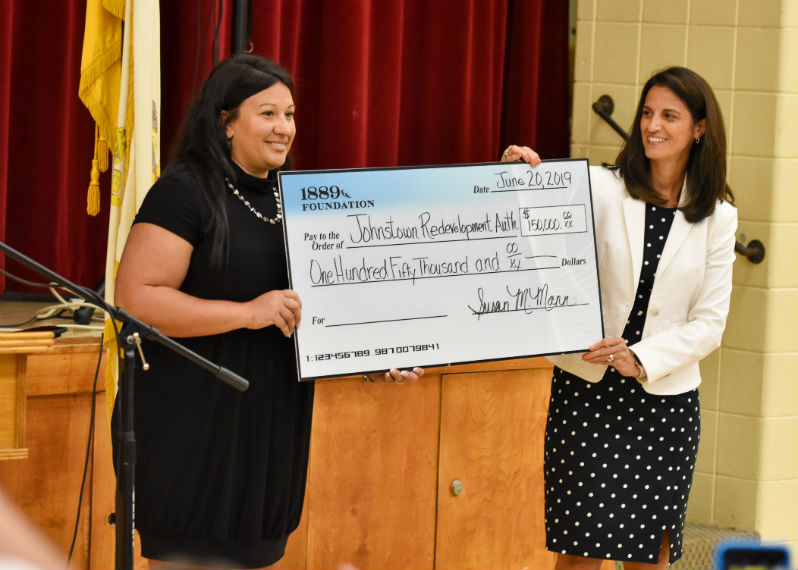1889 Foundation is a major funder of a blight alleviation project in Johnstown’s West End that was announced at a June 20 press conference above (pictured above: Melissa Komar, left, Johnstown Redevelopment Authority executive director, accepts 1889 Foundation’s check from Susan Mann, 1889 president.) The project will enable the Johnstown Redevelopment Authority (JRA), Cambria County Redevelopment Authority, and City of Johnstown to remove 12 derelict, unoccupied structures, of which five are residential and seven are commercial, along a roughly two-mile corridor along Fairfield Ave. and Strayer St.
The effort has been made possible by a collaboration between donors to Community Foundation for the Alleghenies (CFA) and 1889 Foundation. Funding began with a private donation of $75,000 to CFA for blight removal. CFA matched the individual contribution, and 1889 Foundation matched the resulting $150,000 to create a total of $300,000 to fight blight.
“This stretch of road is important to the residents of the West End, but it also is a very visible gateway to the entire City,” CFA President and Executive Director Mike Kane said. “This collaboration is a perfect example of how donors’ intent can be multiplied—in this case fourfold—to revitalize our communities and make the greatest possible impact.”
“Blight is a major problem in our area – and blight has a significant impact on quality of life, and the health and wellness of our community,” noted Susan Mann, president of 1889 Foundation. “This cooperative funding effort with the Community Foundation for the Alleghenies will set the stage for revitalization of this section of the West End, which is an important corridor into our city from Route 22.”
The process began with a meeting on June 6 for the area’s property and business owners. Letters were also sent to inform them of this initiative.
“This neighborhood has a high rate of owner occupancy – that is, the people who live here own their residences for the most part, which means they’re invested in the neighborhood’s future,” said Melissa Komar, executive director of the JRA. “We want to get input from the people who live and work here, so that we can better understand their goals for the neighborhood.”
The 12 blighted structures will be ranked and placed on a timeline based on health and public safety issues, with help from the Johnstown Fire Department and the City of Johnstown Codes Enforcement officers. Work is expected to be completed by the end of 2019. Part of the work will be completed by City of Johnstown employees using JRA equipment, and some of the demolition will be put out for bid from outside contractors.
The JRA envisions future redevelopment of these properties into urban green spaces, raised bed gardens, recreation areas, and side lot projects for neighboring property owners. The area is also zoned for commercial redevelopment, and there are currently parcels available for a larger-scale commercial build in the future.
The project partners anticipate that the blight removal will be a catalyst for not only site redevelopment, but also other types of improvements to the neighborhood.
“For example, funding to improve facades has been allocated from the City of Johnstown, which is also a partner on this project – we hope some in the neighborhood will choose to take advantage of that,” Komar noted. “We look forward to working with the community to revitalize the neighborhood for new businesses and current residents.”

